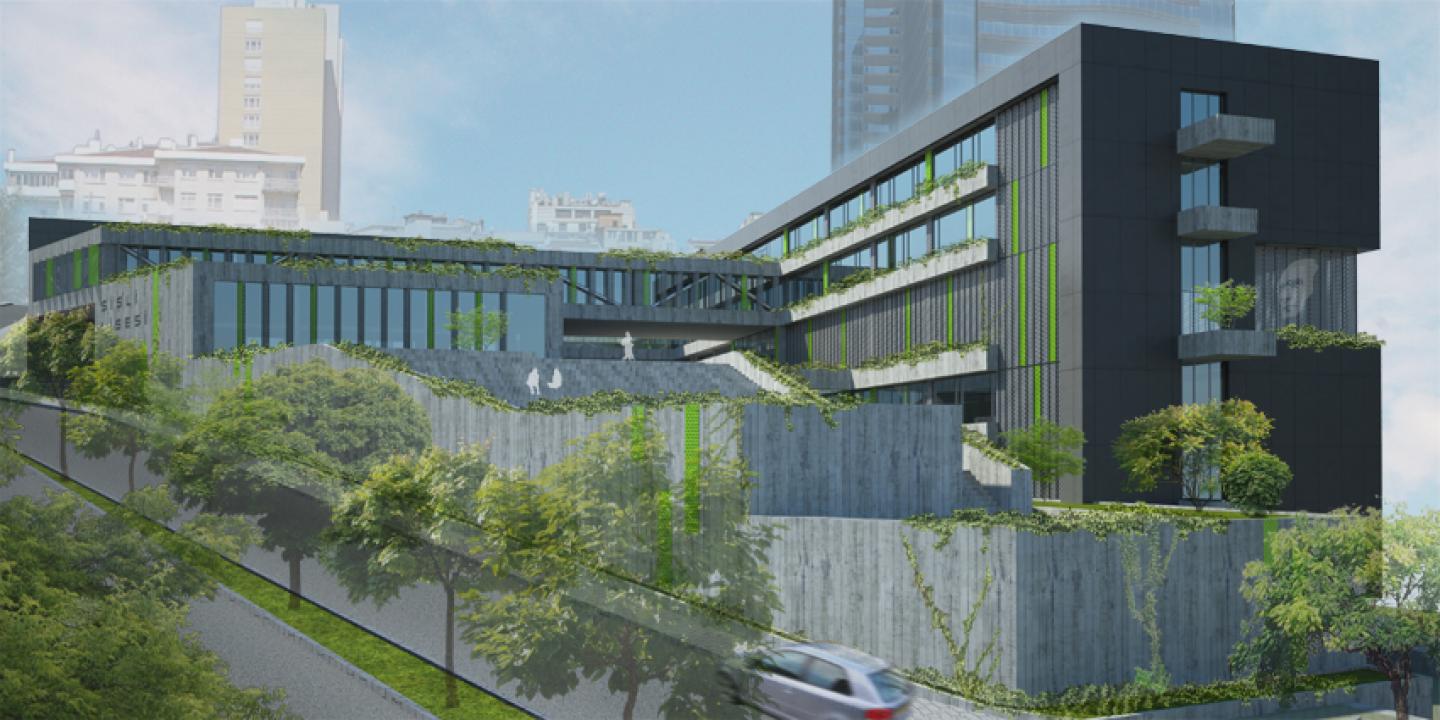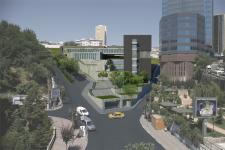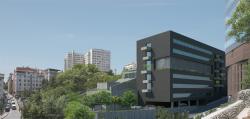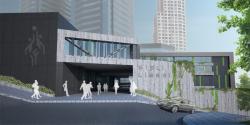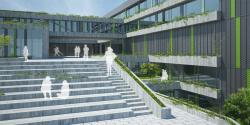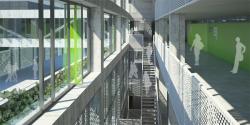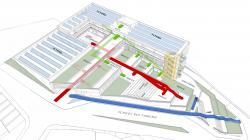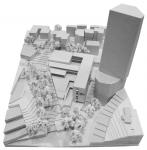Solution of an extensive program within a limited urban area was required in the program. In addition to the spatial requirements of the functions, the irregular geometry and more than 20m rise between the edges of the plot have been the primary inputs shaping the architectural design.
Firstly, the distinct functions given in the program were divided into masses separated by dilatations. Those masses were placed on the terrain according to the slopes of the surrounding streets. Open spaces accessible from each floor were created on their roofs that were designed as the “fifth façades”. By creating open spaces on higher planes than Dr. Sevket Bey Street, the need for fencing or walls around the school was eliminated.
The sports hall was located on the highest level of the terrain since the use of its roof as an open space is the most challenging,. The remaining masses were designed to cascade down to lower levels, in order to minimize the excavation. The heating/cooling load of the bigger volumes of the sports and multipurpose halls were reduced by burying them partially into the ground.
Independent entrances to the education section, social facilities and the sports hall were planned along the “entrance street” planned on Dr. Sevket Bey Street, on the same level as the existing school entrance. The open spaces of the school will be opened to public use through the “entrance street” in a controlled manner by closing the entrances of the buildings. The flooring on the school’s courtyards were continued on the encircling pavements to unite the open spaces with the surrounding. The entrance street is covered by the administration section designed as a bridge able to view open spaces whereas being connected to the education section. By recessing the corner of the education section’s corner, additional semi open spaces were created.
Entrances to both open and covered parking were planned on Kurtbaba Street, which has significantly less traffic. On Dr. Sevket Bey Street with two way traffic, a parking space for school buses was created. It will also be used as additional open parking during periods when the school is closed.
The education section, which takes up the biggest portion of the program, was designed as a narrow and multistory mass, in order to maximize natural lighting. It was located along the northern side of the plot so that the open spaces are opened up to the south and the classrooms are shifted away from the busy Dr. Sevket Bey Street. Moreover, looking from the open terraces of the school, the gargantuan Tatlici skyscrapers will be partially covered by the ascending mass of the education section.
Classrooms in the education section were planned along the north façade so that they are opened up to the quiet Kurtbaba Street and get diffused sunlight from north. Along the south façade, vertical/horizontal circulation corridors and galleries were created to enable visual connection between floors, as well as between closed and open spaces. During the cold seasons the southern sun will decrease the heating and lighting need of circulation spaces by penetrating through the transparent south façade and the galleries. During warm seasons, operable windows on both interior and exterior façades will enable natural cross ventilation throughout the building mass that spans perpendicular to both prevailing wind directions in Istanbul, namely northeast and southwest.
Spaces with less need for natural lighting, such as laboratories, storage and technical spaces are planned on central parts of lower floors, in order to minimize the number of floors on the education section.
Photovoltaic panels are placed on top of the sports hall and educational section whose roofs are not suitable for recreational use due to structural and security concerns. All the remaining roofs were designed as open spaces with hard surfaces and landscaping with local plants. Moreover, green roofs and photovoltaic panels will be live exhibits of sustainable construction and renewable energy resources for the education of students.
Opportunities for benefiting from ground source heat pumps with pipes under the sports hall will be studied with the mechanical engineer. Use of other sustainable construction methods, such as rainwater and greywater use systems, LED lighting, lighting automation, water saving sanitary equipment, local material use were also considered.
The existing playground and the local authority office next to the eastern edge of the plot were redesigned as the continuation of the cascading landscaping of the project. The local authority office was planned on the lowest level and its roof was united with the park created above.
Vertical sunbreakers made from operable perforated metal panels were placed in front of east and southeast facing façades. No sunbreakers were needed on west and southwest façades that are shadowed by neighboring buildings, as well as on the north façade that doesn’t get direct sunlight. Perforated metal panels were used around the entrance floor to surround the courtyard and to protect the glass façades from ball games played by students.
No other materials than glass, aluminum frames, perforated metal and fibercement panels were used on façades. A certain level of variety and rhythm was achieved by incorporating color and plants integrated with the façades.
Regarding durability and minimum need for maintenance, concrete pavement stones were preferred on open spaces whereas interior circulation spaces were covered with epoxy coating.
Cast in place concrete walls surrounding the building masses will turn into green walls covered with ivy growing out of the plant pots alongside.
2011
2011
19.893,2m² construction area, reinforced concrete structure
Aytaç Manço, Ali Manço, Zuhtu Usta, Pavel Lejdar, Aytek Alkaya
